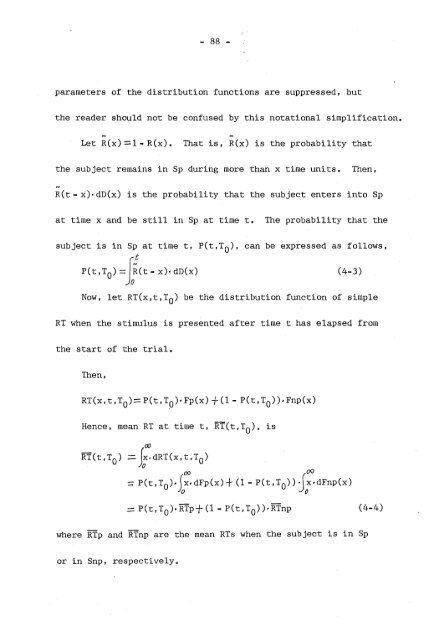A two-state model of simple reaction time
A two-state model of simple reaction time
A two-state model of simple reaction time
You also want an ePaper? Increase the reach of your titles
YUMPU automatically turns print PDFs into web optimized ePapers that Google loves.
- 88 -<br />
parameters <strong>of</strong> the distribution functions are suppressed, but<br />
the reader should not be confused by this notational simplification.<br />
- -<br />
Let R(x) =: 1 - R(x). That is, R(x) is the probability that<br />
the subject remains in Sp during more than x <strong>time</strong> units. Then,<br />
-R(t - x)· dD(x) is the probability that the subject enters into Sp<br />
at <strong>time</strong> x and be still in Sp at <strong>time</strong> t. The probability that the<br />
subject is in Sp at <strong>time</strong> t, P(t,T O )' can be expressed as follows,<br />
P(t, TO) =f,t< t - x), dD(x) (4-3)<br />
Now, let RT(x,t,T O ) be the distribution function <strong>of</strong> <strong>simple</strong><br />
RT when the stimulus is presented after <strong>time</strong> t has elapsed from<br />
the start <strong>of</strong> the trial.<br />
Then,<br />
RT (x , t ,TO) == P( t , TO) •Fp (x) +(l - P(t , TO» •Fnp(x)<br />
Hence, mean RT at <strong>time</strong> t, RT(t,T O )' is<br />
et:J<br />
RT(t,T O ) ;:=. J:,dRT(X,t,T O )<br />
00 00<br />
::; p(t, TO)' fox, dFp(x) +(l - p(t, TO» J;.dFnp(x)<br />
:::: P(t,TO)·RTPt(l- P(t,TO»·RTnp<br />
where RTp and RTnp are the mean RTs when the subject is in Sp<br />
or in Snp, respectively.<br />
(4-4)

















